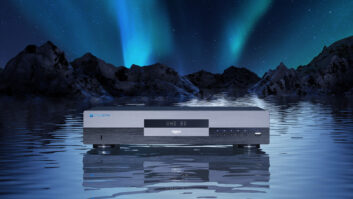It has been almost three months since we outfitted our showroom’s theater with a Dolby Atmos system (read about it here) and I’ve somehow managed to get myself on Dolby’s list of Atmos reviewers, and have been receiving every Atmos Blu-ray disc that has been released. To date, that is five titles: Transformers: Age of Extinction, Step Up: All In, The Expendables 3, Teenage Mutant Ninja Turtles, and John Wick. I’ve had a chance to watch them in Atmos and thought I would use this week’s blog space to “review” the two latest titles, TMNT and Wick, describing the Atmos movie watching experience.
To really experience what Atmos adds to a film, I watched both movies with the main 7-channel floor amplifier turned off, leaving just the four in-ceiling Atmos speakers playing. This gives a true sense of what is being mixed up to the Atmos channels.
While audio mixers are still being mostly restrained in their mixing, not overdoing it with big ceiling mixed audio pans, the Atmos speakers are definitely used extensively to enhance musical scores. Often the ceiling speakers are used to play music at the same volume as the floor channels, creating a huge room-filling sonic bubble. Also, voices are rarely mixed up to the Atmos channels, even when it would seem like the on-screen action might call for it. The mixes so far have mostly reserved voices for some echo when a character is shouting or in an acoustic environment that would have a lot of reverberation.
SPOILER ALERT. There are plot details in my descriptions. Now, on to the reviews!

I remember when the original Eastman and Laird TMNT comic books came out. I was in high school and my friend, Todd Stern, was a big fan. (I personally held volume #1, now worth around $4,000. I wonder if Todd still has it…?) I never really got the allure of the Turtles, so for me the movie was just kind of meh. I think I would have enjoyed it a lot more if I were watching it back in high school, when all of the juvenile sexual references would have (maybe) been edgy and funny. (And how is a giant turtle supposed to have human sex? I mean, logistically…)
When a film features Megan Fox as an “intrepid reporter,” you pretty much know what you’re going to get. As you would imagine, this is film is filled with big effects shots but surprisingly few explosions for a Michael Bay-produced film. It was a decent enough way to pass 101 minutes, but Citizen Kane it ain’t. Visually, the 2.35:1 Blu-ray transfer looks great and of the two movies, this one is far more demo-able as Wick will likely be too brutal for most viewers or a showroom presentation.
Sonically, I figured this would be a real workout of the Atmos speakers, with opportunities for tons of big effects mixed up to the ceiling channels, but it was more restrained than I expected. There was certainly a ton of audio going on overhead throughout, but not as aggressive as I imagined the mixer would have pushed in such an over-the-top (no pun intended) film. Also, it seemed like the movie missed out on several opportunities for big mixes to the ceiling, especially as there were a lot of fight scenes with jumping around the room, yet the height channels were predominantly used for music and background sounds. Here are some scenes that stood out for me sonically:
At roughly the 7:30 mark there is a lot of overhead activity in the turtles’ first appearance, with sonic swirling and jumping around. There are also a lot of thunder and rain effects to set the outdoor scene.
At 16:30 there is a lot of overhead dripping and pipe noises inside the turtle’s subway lair.
At 22 minutes Megan Fox is regaining consciousness, and we hear the turtles’ voices floating and swirling out of the ceiling channels, doing a nice job of simulating her disoriented and confused (ie: her normal daily life) state.
At 27 minutes, the turtles sneak through a sewer while have a conversation, and their voices echo into the overhead channels, creating a far more realistic sonic environment.
During a big fight scene with Shredder — a cross between a kind of giant Swiss Army knife and samurai Transformer — at 52:30 there are some cool effects where knives seem to pass through the room, flying right past your head.
Chapter 14 has an overly long — like five minutes — scene where they are racing/crashing/sliding down a snowy mountain with lots of vehicles flipping and spinning. This scene would definitely make for an exciting demo, but surprisingly it isn’t big on Atmos audio beyond the music and some swirling snow sounds.
Near the end of the film, around during the climactic final battle, a tower is collapsing with bits of metal and debris crashing down all around and overhead. And in a scene that nicely displays the use of sound, our heroes are having one of those impossible falling moments that no mortal being could possibly survive while Raphael maintains a running, “I love you guys!” dialog and the music abruptly stops and there is this sudden moment of just silence with just bits of building debris falling around the room.

Where TMNT is campy, bloodless, and tongue-in-cheek, conversely John Wick is slick, serious, and brutal. The disc’s featurette, “Don’t F*#% With John Wick,” basically sums it up. Things don’t end well for people that cross Wick. Imagine Liam Neeson in Taken, but like if Liam were really pissed off and bent on exacting revenge.
If you picture Keanu as the “Whoa! Dude!” from Bill & Ted or even the “I know Kung-Fu” Matrix version, prepare to meet a new Reeves. He inhabits the role of Wick as the ultimate ex-mob hit man bent on revenge perfectly and believably. He is a man of few words, choosing instead to let his pistol do the talking. And it has a lot to say.
The film is fast-paced, with several big fight scenes often filled with tons of gunfire and glass shattering mayhem. Wick is visually very stylistic with a cool, bluish-grey color palette in many scenes. The 2.35:1 aspect film looks great, with nice deep blacks and good contrast. Sonically it has a ton going on as well, with some serious bass and quite a bit of Atmos activity. Be very selective in who you demo this film to as many of the actions scenes include brutal violence and no shortage of cranial arterial spray from close-up gunshots. Here are some scenes that stood out for me sonically:
The film starts off building the story, and in the first 11 minutes Wick’s wife dies and her heart monitor flat lines up into the ceiling channels. This is followed by an outdoor funeral where rain pelts down and cascades around the room. Following this is an outdoor scene with lots of outdoor atmospheric sounds and crickets chirping. And then Wick jumps into his ’69 Mustang Mach 1 with the garage door sliding open overhead.
At 13 minutes there is a lot of car screeching and sliding around as Wick races around in the Mustang.
The movie really kicks in at 16 minutes, during a horrible break-in. There is a pretty brutal moment and then the music abruptly ceases and we cut to Wick digging a grave. This sudden sonic stillness adds to the weight and solemnness of the moment.
At 17:30 Wick visits an auto garage and there are a lot of mechanical ambient sounds of banging tools and air wrenches and some of the recalled dialog is ghosted up into the ceiling channels.
There are several scenes throughout the film (at the 21-, 33-, and 67-minute marks) where the Atmos channels do a really great job of creating the indoor sonic space while people are talking. Even though it is just dialog, the speakers fill the room with a bit of air and ambience and set the acoustic space more realistically. At the 77-minute mark, the calmness of a hotel lobby is highlighted with some cheesy background elevator music.
At 24 minutes, Wick prepares to get down to work, using a sledgehammer to bust up some concrete to retrieve his kit. His sledgehammer blows are punctuated powerfully up into the ceiling adding a ton of weight to each strike.
The first big fight happens at 29:30, and gunshots and shattering glass fill the overhead channels adding intensity to an already intense fight. The music and cacophony abruptly ends as a doorbell chime fills the space, returning the evening to sonic normality.
At 41 minutes, Wick visits a club and there is a ton of ambient club music and conversations and dinner plates and glasses clinking. Minutes later at another private club, the music plays an important role in letting you know which level or area of the club you’re in and the overhead channels do a great job of filling in the room space and setting the difference moods as characters move through the differences spaces. This scene is punctuated by blasts of silenced pistol fire as Wick moves through the club taking out bad guys and finishes with two loud blasts from Wick’s unsilenced back-up weapon.
At the hour mark, Wick visits a church and there is some nice ambient pipe organ and massive echoes of mid-arms fire filling the reverberant space. This is followed by an outdoor, street gun battle similar — but more brutal and not nearly as long — as the epic scene from Heat.
During the film’s big finale, I felt they missed a moment for a nice overhead Atmos effect as a body literally rolls right over the top of Wick’s car. However, the audio mixer makes up for this by having a ton of massive gunfire throughout. Also, adding to the sonic drama a massive rain storm comes out of nowhere, filling the overhead channels with a downpour for the final showdown.
John Sciacca is principal of Custom Theater and Audio in Myrtle Beach, SC.








